Some people think that flowers should just grow in a flower garden and vegetables should just grow in a vegetable garden! I have always either surrounded my vegetable gardens with flowers or I’ve interplanted flowers in the vegetable garden. I know a lot of you are in the process of planning your vegetable gardens and I just want to encourage you to plan on adding flowers this year if it’s something you don’t already do. It’s a great way to attract pollinators to your garden!
How To Attract Pollinators To Your Garden
There are several good reasons to add flowers to your vegetable garden besides the beauty they add. Although “companion planting” is a debatable gardening method (one which I find fascinating), it has been proven that flowers attract pollinators to a vegetable garden.
Disclosure: This post may contain affiliate links to Amazon and/or Etsy, which means that I may earn a small commission from some of the links in this post. Please see our Disclosure Page for more information.
A flower’s blossoms and fragrance attracts pollinators that are important to the success of your vegetable garden. Although there are some plants that are wind or self-pollinated, most plants need a pollinator.
Who Are Pollinators?
Bees, butterflies, moths, bats, humming birds, beetles,
wasps and flies.
What do pollinators do?
Basically, your garden needs pollinators like bees and butterflies to transfer the pollen from the male part of your vegetable to the female part in order for fruit to develop. Vegetables that we grow for the leaves like lettuce & spinach and vegetables that we grow for their roots like carrots and radishes don’t need pollinators. Vegetables like peppers are self-pollinating but set more fruit if pollinated by bees. But vegetables like squash definitely need pollinators otherwise you have to pollinate those squash blossoms by hand!
It is said that bees are more attracted to flowers that are white, yellow, orange, scarlet, blue, violet and purple such as coneflowers, cosmos, bachelor buttons, daisies, zinnias and sunflowers. Butterflies like yellow, red and purple flowers like asters, calendula, and sunflowers. Hoverflies and wasps like candytuft and daisies.
Borage which actually is a herb is supposedly one of the best bee attractors . I’ve never grown it before but I ordered some seeds this year so I’ll be trying it out.
***A word about my experience with growing sunflowers in my vegetable garden.***
One year I used mammoth sunflowers in a “3 sisters” method which normally is growing corn, squash and pole beans together and I discovered that squash beetles loved laying their eggs on the underside of the huge leaves of those sunflowers – waaaay at the top! I had to climb on a ladder to get at those squash beetle eggs and had a very hard time controlling them until I ripped out those big sunflowers.
So I don’t grow the really tall sunflowers in my veggie garden anymore just the shorter ones!
Pollinators like bunches of flowers which is why I often plant a container of flowers and place it that the end of a bed. I also dedicated one raised bed just for flowers last year.
Some other tips for attracting pollinators to your garden:
-plant native flowers because your native bees are more attracted to flowers that are familiar to them
-do not use chemicals in your veggie garden. Pesticides and herbicides kill bees and honey bee populations are declining as it is! If you must use a pesticide try to do so in the late afternoon or evening since bees are most active early in the day.
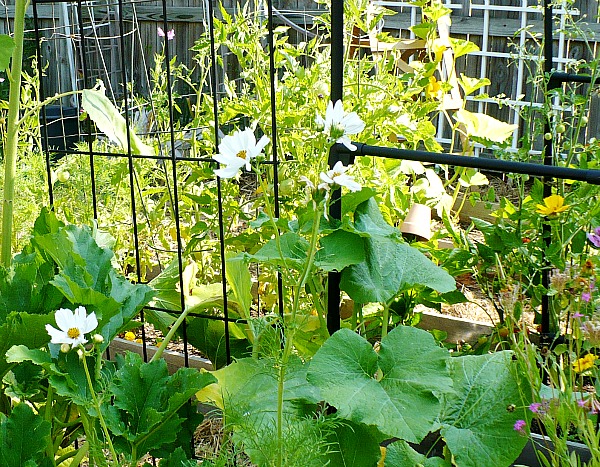
You can find a list of plant names that will attract pollinators at Pollinator.Org All you have to do is enter your zipcode to find your ecoregion and get a list of plants that are specific to where you garden (the list is at the end of the document).
I think flowers deserve to be in all vegetable gardens! Will you be adding flowers this year?
Check out the other posts in my Gardening 101 Series.


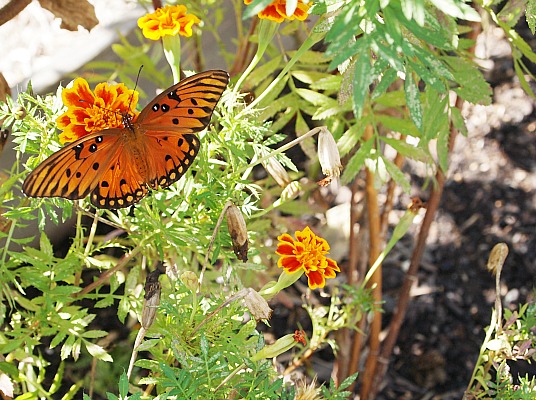

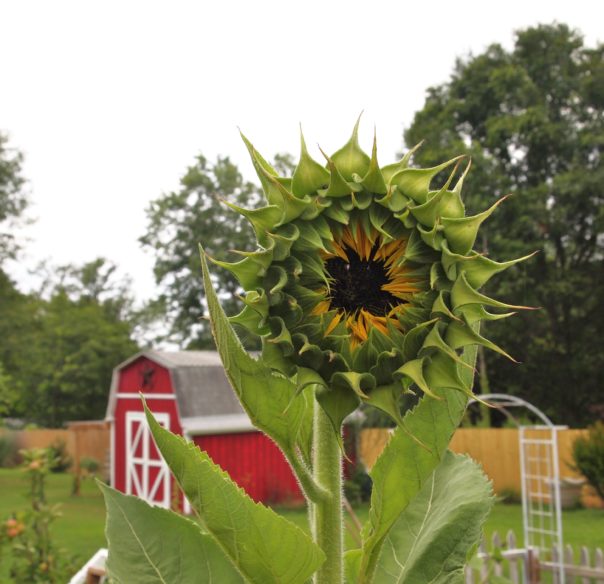
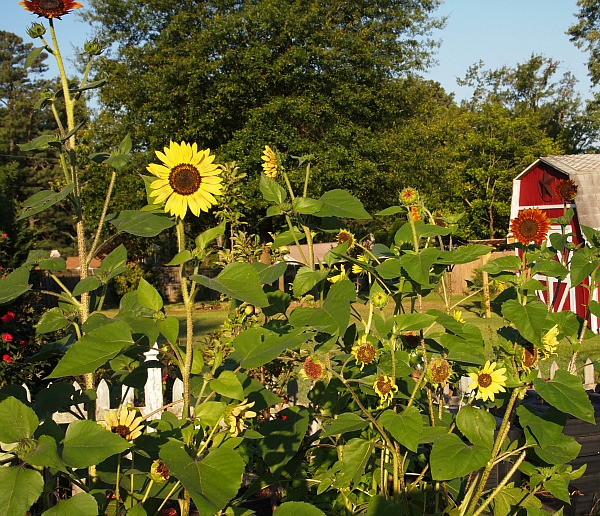

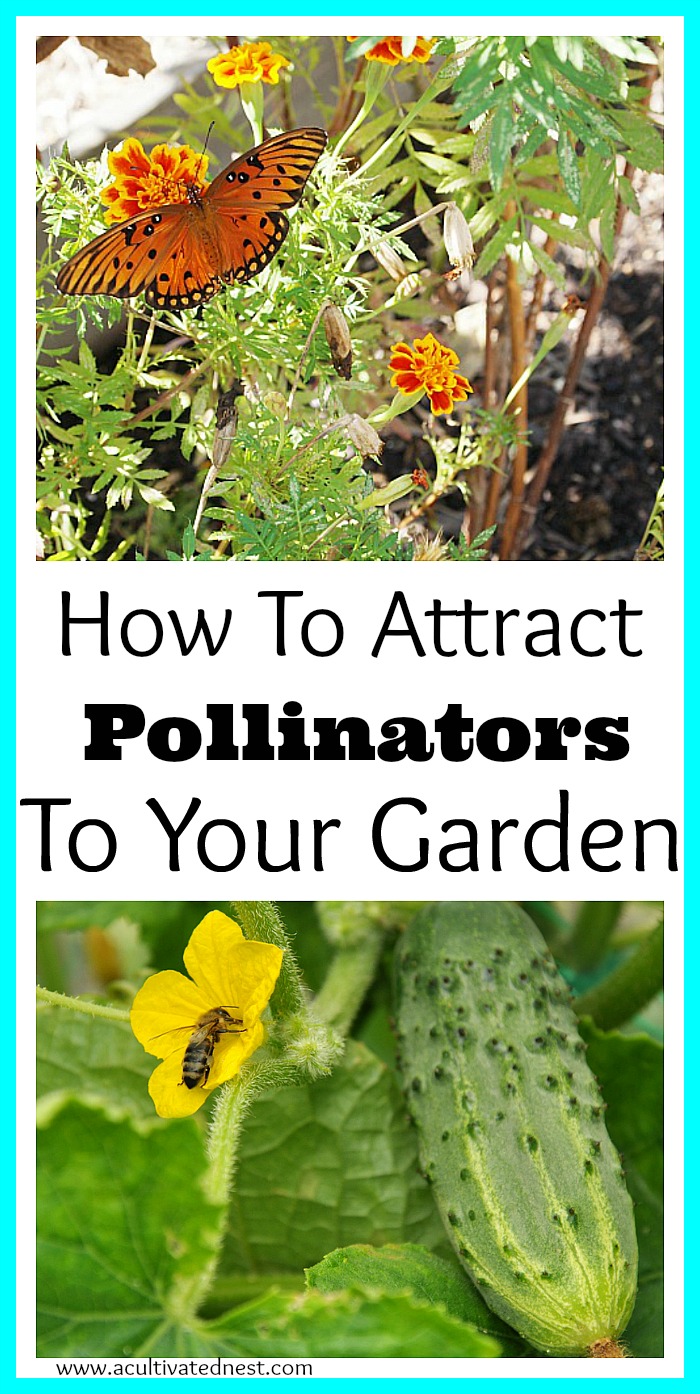
Oh yes, I added some flowers yesterday and
it looks good. Your photos are really nice
and I wish I had your garden…
Sandy
I am using your advice and passing it along to my Hubby! He has our garden beds ready! Thank you so much for sharing this information and link! HUGS!
I always add flowers tot he garden, last year I bordered all the beds with the most amazing marigolds, I swear we had less bug problems:>)
Great post! I usually plant marigolds in and around my green beans. I don’t know that it does that much good, but the last time I had a much better yield of green beans. I hadn’t really thought of planting flowers as pollinators, but it makes perfect sense.
I understand the need to be careful with pesticides. What do you do for garden pests?
I don’t have any garden pests except squash bugs and I usually hand pick those off and look for and destroy their eggs. I’ve learned that starting my squash early and using row covers in the beginning of the season helps to cut down on those. I don’t have any other bug problems probably because I practice companion planing and I do use lots of flowers in my garden which attract beneficial insects that eat the “bad” insects (a topic of part 2 of this series) 🙂
companion planting not companion planing 🙂
I love the look of flowers in with the vegetable garden. I usually plant marigolds and zinnias. It just makes me happy.
This is what I do as well. We always have at least nasturtium in the garden…this year I want to add a few more as well.
We rarely have pests in our garden either – just had some bugs on a pole bean plant once.
I’ve read that bugs usually only bother plants that are not healthy, so if you have healthy soil and healthy plants you shouldn’t have too many pests.
I know that I’ve said this before, but I will say again that I would love to come to your home and just walk among the beds in your garden. You have the “dream” garden to me. Thanks for the info about the pollinators. (And I didn’t realize that there was more than one kind/height of sunflower.)
Hello
I really love your garden posts. I’m getting ready to start a larger vegetable garden this year and find your site so inspiring. I agree with planting flowers for pollination as well as keeping out the pests. Marigolds helped keep the green worms out of my tomatoes when they invaded one year. I plan to use alot of flowers this year. Your garden decor is so cute. Where did you get your garden signs and other decor?
Thank you Marlene! Yes, marigolds are great to add to your garden. I have a post on using plants for pest control coming up.
I’ve gotten my yard art in various places. I get most of my stuff in regular stores like Hobby Lobby, Michael’s, TJMaxx. I’ve also painted some signs and I made those hose guides last year I think.
I added zinnias to my garden last year along with my usual flowers. If nothing else, they seemed to attract hummingbirds!
A very informative and timely post, Manuela.
I have a small raised bed in which I tried to grow zucchini two years in a row. Believe it or not I couldn’t even grow one squash. I read about the pollinator issue and even tried to do it myself with a Q-Tip to no avail. Although I have flowers sprinkled all over the yard, this year I will put some right in the bed and try growing zucchini again this year. I am determined. I always thought it was so easy to grow.
Thanks for the great info.
Great info! We have 9 raised beds for vegetables and I always plant flowers in the middle one.I like vegetable gardens that are pretty too.
The only pests I’ve really had trouble with are the squash bugs. I hate them! Now I plant squash and relatives back by the compost piles:)
I know! I really only have problems with squash bugs too. Supposedly nasturtiums are good to plant with squash as a deterrent. I’m going to try that this year.
I guess one advantage of having limited sunny garden space is that my veggies and flowers have always been mixed together. I think you’ll love the borage–such a gorgeous blue! And yes, the bees go crazy for them.